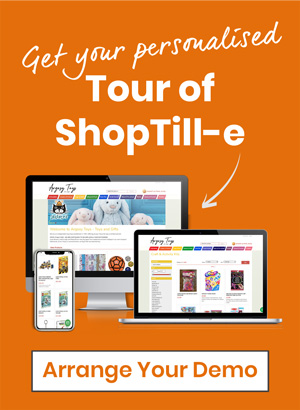Benefits of multichannel retailing for merchants and customers
Perhaps you sell online through an ecommerce website or marketplace. Maybe you have a retail shop or sell at exhibitions, events and festivals. Whatever your channel of choice, you’ve likely considered multi-channel as a way to expand your business and improve your profits.
Multi-channel retailing has advantages for both merchants and customers, offering greater freedom and flexibility for many companies today.
How do you know if multi-channel retailing is the best fit for you?
We take a closer look at some of the biggest benefits, as well as a few of the things you should consider before you make your choice:
Advantages for the merchant
Boost sales
When you offer your products through more sales avenues, you’re able to increase your visibility and brand, as well as tap into more areas of the market and gain more new customers, and therefore make more sales.
The different sales channels can also offer various opportunities for upselling; from impulse purchases to an everyday essentials at a physical till point in your shop, to displaying personalised recommendations in your ecommerce website, based on items that other customers bought with a similar purchase.
But it’s not just visibility that is advantageous to you as a merchant. It’s also the fact that you can be available to your customers around the clock. This is especially vital considering the way shopping habits have changed as mobile consumerism grows and expands.
Shopping 24/7 is a modern reality, and being multi-channel can allow you to tap into the opportunity to succeed beyond set store hours.
Improve customer loyalty
Nowadays, customers expect to be able to make purchases on the go and while engaged in other activities.
Multi-channel retailing allows you to offer a more seamless, integrated experience across a range of sales channels, as well as provide more accessible customer support in person, through phone, email, live chat or social media.
Loyalty is more important for a business than any other form of marketing. Anything from online reviews to social media recommendations can hold considerable weight when it comes to selling your products.
In turn, you’ll find you’re rewarded with loyal customers who purchase more, better reviews, swifter resolutions and customers who perceive you as forward-thinking, offering a service catered to them that not everyone else does.
Using customer segmentation and data insights gained through the various sales channels means you can also make sure only relevant information and offers are communicated to your audience.
Create diverse channels to suit different products
One of the most significant advantages of using multi-channel retailing is it gives you the freedom and flexibility to be more diverse with your customers.
By not limiting yourself to one style of sales, it’s easy to target different demographics – or even completely different audiences – with your product range. For example, if you sell clothing products, including shoes, underwear and other specific items, then it’s possible to sell shoes on one platform individually, and underwear on another.
This creates a better experience for your customers, fewer products to wade through to find what they want and the opportunity to discover similar items they may also enjoy far more quickly.
Gather insightful data
If you make sales online, instore and over the phone, multi-channel retailing allows you to collect a range of data on your customers to help you build a profile of your audience.
Things like their demographics, purchasing history, interests, as well as the time, location and device they shop from, are crucial insights that can help inform your marketing campaigns and sales strategy and boost your ROI. Analytics and the ability to target your demographic is vital to creating campaigns with lasting impact, that are suited to your audience of choice.
They also provide information to allow you to adjust your promotion according to your actual audience, vital feedback that non-digital channels can’t offer.
Benefits for the consumer
Convenience for purchasing
With people leading more hectic lives, the most significant benefit of multi-channel retailing to customers is convenience.
Those who need something urgently can order online and collect in store or at another affiliated location nearby, while others who might work awkward hours can arrange for delivery at a time that suits.
Multi-channel retailing could also mean expanding your presence into online marketplaces to make life easier for customers who already have an account, instead of having to set up a brand new one. A study by PwC on consumer habits found that 58% of shoppers already use Amazon.
Modern services for modern customers
Promoting your products to customers is about more than just making them visible. Customers expect a certain level of service, and by catering to their modern requirements with modern channels, you can prove you’re putting them first.
Online functionalities such as offering to check out as a guest or as an existing customer, and payment methods you use specifically, like PayPal, can have all have an impact, as well as features like integrated payments when buying in-store, for quicker queues and faster buying.
Multi-channel retail benefits customers because it allows them to have the high level of service they expect, without the need to go out of their way to purchase your products.
Manage preferences
With multi-channel retailing, customers can pick and choose how they shop.
Different formats of selling fulfil different functions, with some customers preferring to sit down and browse online in front of the TV, while others being reassured that they can order something urgent at the click of a button on their morning commute and others wanting to pick up from your shop at lunchtime when it suits.
Hand in hand with this, accessing your shop through different media means they’re also able to manage what information they give and select how they would like to be marketed to so that they get a service tailored to their needs.
Customers feel rewarded
Using the data you receive on your customers, you can give them more of what they want so that they feel looked after and rewarded.
According to PwC, 59% of customers said they want real-time offers designed just for them. You can target flash sales, promotions and voucher codes to be seen by certain groups when you utilise the insights and technology behind multi-channel retailing.
Rewarding your customers is just as rewarding for you as a merchant, as it encourages repeat purchases and visits further down the line, as well as offering more opportunity for positive reviews and useful feedback.
Factors to consider about multichannel retailing
Stock control and inventory management
One thing to consider before making the leap to multi-channel retailing is inventory management of your internal stock.
While keeping a close eye on levels of stock with one channel is easy, each additional channel you add creates a new challenge. It’s vital to have a sound stock control system in place to ensure what you’re providing online is available, accurate – and more importantly – ready for sale and delivery when you say it is.
To be successful in multi-channel retail, stock control is the first step to take. Once that requirement is in place, you’re prepared for anything.
More management required
Beyond stock, it’s also crucial for merchants to understand the management required for additional channels.
Whether it’s providing customer support, ensuring quality control on all your listings and making sure products are uploaded and maintained correctly, management should be at the forefront of your plans. This management includes costs, such as those related to fees on particular platforms, as well as the overall marketing required to keep a steady flow of customers. Once management procedures are effectively in place, it’s entirely possible to run multi-channel retailing smoothly.
This management includes costs, such as those related to fees on particular platforms, as well as the overall marketing required to keep a steady flow of customers. Once management procedures are effectively in place, it’s entirely possible to run multi-channel retailing smoothly.
Meeting customer expectations
As you can imagine, customer experience is a vital part of succeeding in multi-channel retail. With just one retail channel, offering exemplary customer service is relatively straightforward.
But with the addition of more sales channels and more systems, understanding customer support systems and functions on each channel is a must. Fulfilling the expectations of your customer means that consistency is vital, with the same level of support offered everywhere.
If you can achieve that, then you’re in a far better place to keep existing customers happy as well as impress those new to your business.
Multichannel retailing the smart way
At ShopTill-e, giving your customers multiple ways to shop doesn’t mean having to manage several points of sale software.
Not only does this mitigate some of the concerns related to working with various channels, but it also provides the productivity needed to go above and beyond.
With the ShopTill-e all-in-one retail system, succeeding on multiple channels is easier than ever.
We make things simple, with our fully featured and combined cloud ePOS system and ecommerce platform. Our all-in-one retail system syncs up seamlessly, keeping all your products and inventory data updated continuously. So whether you sell online or through your shop, or through a virtual marketplace like Amazon and eBay, ShopTill-e helps you to spend less time managing and more time selling.
Eliminate unnecessary back office inefficiencies and boost productivity - start your free 14 day trial today.




